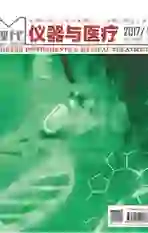全覆膜自膨式金属支架治疗良性胆管狭窄临床观察
2018-01-09李攀卢媛张彦张金卓
李攀 卢媛 张彦 张金卓
[摘 要] 目的:觀察全覆膜自膨式金属支架(Fully covered self-expandable metal stent,FCSEMS)治疗良性胆管狭窄(Benign biliary strictures,BBS)的临床效果,探讨其应用价值。方法:观察2013年3月至2017年2月43例接受内镜下FCSEMS置入的BBS患者治疗效果(症状、生化指标)及并发症发生情况,总结治疗体会。结果:43例患者FCSEMS均一次性置入成功,成功率为100.00%;术后随访期间3例患者支架未起效,支架有效率93.02%。有效患者随访期间均未见发热、黄疸、腹痛等症状复发,支架通畅性均良好;所有患者金属支架均成功回收;患者术前血清TBIL为(246.80±62.65)μmol/L,术后5~7 d降至(95.92±17.65)μmol/L,术前与术后血清TBIL比较,差异有统计学意义(P<0.05)。患者术后早期并发症以胰腺炎、高淀粉酶血症为主,均经对症治疗后好转,1例死亡患者死于急性肾功能不全加重继发多脏器功能衰竭。结论:FCSEMS治疗BBS安全、有效,是BBS治疗的可行选择。
[关键词] 全覆膜自膨式金属支架;良性胆管狭窄;内镜逆行胰胆管造影
中图分类号:R575.7 文献标识码:A 文章编号:2095-5200(2017)05-055-03
DOI:10.11876/mimt201705023
Clinical observation of fully covered self-expandable metal stent in the treatment of benign biliary strictures LI Pan, LU Yuan, ZHANG Yan, ZHANG Jinzhuo. (Department of Gastroenterology,Baoding First Central Hospital, Baoding 071000,china)
[Abstract] Objective: The objective of this study was to investigate the clinical effectiveness of fully covered self-expandable metal stent (FCSEMS) in the treatment of benign biliary strictures (BBS) and to explore its application values. Methods: A total sample of 43 cases of BBS patients who had accepted endoscopic FCSEMS from March 2013 to February 2017 were chosen as study objects. The treatment effectiveness (symptoms, biochemical indexes) and occurrence of complications were observed and the treatment experience was summarized. Results: FCSEMS was successfully implanted in all 43 patients at one time, with a success rate of 100%. During the follow-up period, 3 stents failed, and the stent efficiency was 93.02%. During the follow-up period of effective patients, no fever, jaundice, abdominal pain or other symptoms were recurred, and the patency of stent was good. All patients metal stents were successfully recovered. The preoperative serum TBIL was (246.80±62.65) μmol/L and the postoperative 5-7 d serum TBIL dropped to (95.92±17.65) μmol/L. The difference between preoperative and postoperative serum TBIL was statistically significant (P<0.05). The early complications of these patients were mainly pancreatitis and amylase which were all improved after symptomatic treatments. 1 patient died from acute renal insufficiency aggravation and secondary multiple organ failure. Conclusions: FCSEMS is safe and effective in the treatment of BBS and is a viable option for BBS treatment.
[Key words] fully covered self-expandable metal stent; benign biliary strictures; endoscopic retrograde cholangiopancreatographyendprint
良性胆管狭窄(Benign biliary strictures,BBS)常继发于胆管炎症、慢性胰腺炎,随着腹腔镜微创手术的广泛开展,医源性损伤所致BBS发生率日益增多,而传统手术治疗BBS存在并发症发生风险大、复发率高的弊端,已逐渐被内镜治疗所取代[1]。内镜下球囊扩张或塑料单管支架放置是既往临床治疗BBS的首选方式,但需重复多次治疗,给患者带来了较大痛苦,且2年内支架取出后狭窄复发率超过30%[2]。全覆膜自膨式金属支架(Fully covered self-expandalbe metal stent,FCSEMS)良好的支撑性能够维持胆管的长期通畅[3]。我院将FCSEMS用于BBS患者,取得了较好的效果。
1 资料与方法
1.1 一般資料
43例BBS患者年龄≥18岁,于我院接受内镜逆行胰胆管造影(ERCP)[4]及FCSEMS置入治疗且临床资料保存完整,排除既往有胆管金属支架置入治疗史及经皮经肝胆管引流术治疗史者。43例患者中,男24例,女19例,年龄32~81岁,平均(48.55±11.26)岁,胆管狭窄长度1.3~5.7 cm,平均(2.81±0.55)cm;病因分布:胰腺癌26例,胆管癌6例,壶腹周围癌5例,自身免疫性胰腺炎1例,IgG4相关胆管炎1例,炎性胆管狭窄2例,病因不明2例。
1.2 治疗方案
患者术前完善血常规、血生化、出凝血功能等相关检查,禁食、水8 h,术前30 min静脉注射5~10 mg地西泮、
50 mg哌替啶及20~40 mg丁溴东莨菪碱,术前5 min口服10 mL盐酸利多卡因凝胶,年龄较大、体质较差或耐受度较低者,酌情减少麻醉药物用量[5]。予面罩吸氧、心电监护,患者取俯卧位,行ERCP检查,明确胆道狭窄部位、长度及距乳头距离,于胆管内留置导丝,切开Oddi括约肌,根据ERCP检查结果选择合适长度的FCSEMS(直径10 mm,购自波士顿科学国际有限公司),支架长度最短40 mm,最长80 mm,于导丝引导下缓慢释放金属支架,内镜及X线下明确支架位置良好后退出导丝及推送器[6]。术后禁食、水24 h,常规应用抗生素3~5 d预防感染,同时给予质子泵抑制剂静脉输注及补液处理。术后随访期间,定期复查血常规、生化及腹部B超,发生胆管梗阻或支架移位者再次入院接受支架更换治疗。
腹痛、发热、黄疸等临床症状好转,彩超显示狭窄减轻或恢复正常,随访12个月未见狭窄复发;肝功能好转,血清总胆红素(TBIL)水平明显下降为治愈[7]。
1.3 统计学分析
对本临床研究的所有数据采用SPSS18.0进行分析,血清TBIL以(x±s)表示,并采用t检验,以P<0.05为差异有统计学意义。
2 结果
43例患者FCSEMS均一次性置入成功,成功率为100.00%;支架长度40~60 mm,其中37例患者置入60 mm支架,占86.05%;术后随访期间3例患者支架未起效,支架有效率为93.02%。
患者均获得有效随访,随访时间2~15个月,中位随访时间8个月,支架有效患者随访期间均未见发热、黄疸、腹痛等症状复发,支架通畅性均良好;所有患者金属支架均成功回收;患者术前血清TBIL为(246.80±62.65)μmol/L,术后5~7 d降至(95.92±17.65)μmol/L,术前与术后血清TBIL比较,差异有统计学意义(P<0.05)。
患者术后30天内早期并发症以胰腺炎(30.23%)、高淀粉酶血症(9.30%)为主,均经禁食水、抗炎、保肝、抑酸、抑制胰液分泌、抗感染等对症治疗后好转,其余为急性化脓性胆管炎(6.98%)、急性肾功能不全(4.65%)、1例死亡患者死于急性肾功能不全加重继发多脏器功能衰竭;术后随访期间1例支架移位患者未出现梗阻性黄疸,故未行支架二次置入,3例支架堵塞患者病因均为恶性肿瘤的进展与复发。
3 讨论
自20世纪90年代中期内镜下胆道支架置入的动物实验获得成功以来,该技术已成为各种原因所致胆道狭窄的首选方案,既往临床常用的塑料支架能够在短期内有效解除狭窄,但管径较小、通畅时间短、堵塞发生率高,且每隔3~6个月需再次更换支架,重复多次的内镜治疗不仅给BBS患者带来了较大痛苦,也使得内镜医生的工作量显著增加[8-9]。
为克服塑料支架的堵塞问题,有学者建议将恶性胆管狭窄的FCSEMS用于BBS的治疗,以期借助金属支架管径大、通畅时间长、无需反复更换等优势,提高BBS的治疗成本效益[10]。与金属裸支架相比,FCSEMS在金属网孔表面覆盖了一层相容性佳、可有效避免细菌粘附的有机薄膜,从而抑制组织细胞沿支架网孔的内向生长,达到保证支架通畅率的目的[11]。此外,FCSEMS属全覆膜支架,较裸支架、部分覆膜支架而言,内镜下移除更为简便、安全,更符合BBS的治疗原则[12]。
既往部分学者就FCSEMS与传统塑料支架治疗BBS的安全性与有效性进行了对比,结果发现,多塑料支架虽然能够实现狭窄部位的更大扩张,但平均每例患者需接受5次ERCP操作,且支架有效率不足90%,而FCSEMS除具有可回收性外,还具有更宽的直径以及持续性扩张特点,能够在减少ERCP操作次数的基础上,进一步延长胆管通畅时间[13-15]。本研究结果示,FCSEMS治疗BBS的支架有效率达到93.02%,且随访期间支架通畅性良好,印证了FCSEMS确切的治疗效果。
在术后并发症的观察中,可以发现,虽然患者术后胰腺炎发生率达到30.23%,但患者胰腺炎表现均较轻微,保守治疗即可确保疾病好转;高淀粉酶血症的发生率为9.30%,仅次于胰腺炎,但患者症状均为一过性,经对症处理后均可于72 h内治愈。既往研究发现BBS患者术后胆囊炎、胆管出血、胆管穿孔风险较高,其原因与手术操作不当及胆囊管引流受阻有关[16],但本研究43例患者术后均未见上述并发症,说明全覆膜支架虽然可能造成肝内胆管、胆囊管或胰管开口阻塞,但其良好的生物相容性能够有效避免术后严重并发症的发生[17]。随访期间有3例患者发生支架堵塞,考虑与肝内小分支胆管堵塞有关;1例患者发生支架移位,其原因为金属支架对粘膜上皮细胞粘附功能的抑制。上述晚期并发症的发生均可能导致支架失效,但对于未发生梗阻性黄疸的支架移位患者,可行保守治疗,无需内镜再次干预;需要注意的是,也有部分支架移位可导致疼痛甚至肠梗阻,且支架移位后取出较为困难,尽管这一现象临床发生较少,也应予以高度重视[18],可通过借助导管内双极射频消融技术进一步改善狭窄程度,降低肝内小分支胆管堵塞所致支架移位风险。endprint
综上所述,FCSEMS治疗BBS具有可行性,能够避免多次内镜操作对患者造成的巨大痛苦,从而在缩短治疗周期的同时,降低并发症发生率、保证治疗效果,其临床应用价值值得肯定。
参 考 文 献
[1] Devière J, Reddy D N, Püsp?k A, et al. Successful management of benign biliary strictures with fully covered self-expanding metal stents[J]. Gastroenterology, 2014, 147(2): 385-395.
[2] Irani S, Baron T H, Akbar A, et al. Endoscopic treatment of benign biliary strictures using covered self-expandable metal stents (CSEMS)[J]. Dig Dis Sci, 2014, 59(1): 152-160.
[3] 田青, 王桂杰, 張雅敏, 等. 全覆膜自膨式金属支架在治疗肝移植术后胆道吻合口狭窄中的应用[J]. 中华器官移植杂志, 2015, 36(4): 201-204.
[4] Chathadi K V, Chandrasekhara V, Acosta R D, et al. The role of ERCP in benign diseases of the biliary tract[J]. Gastrointest Endosc, 2015, 81(4): 795-803.
[5] Coté G A, Slivka A, Tarnasky P, et al. Effect of covered metallic stents compared with plastic stents on benign biliary stricture resolution: a randomized clinical trial[J]. Jama, 2016, 315(12): 1250-1257.
[6] Mangiavillano B, Manes G, Baron T H, et al. The use of double lasso, fully covered self-expandable metal stents with new “anchoring flap” system in the treatment of benign biliary diseases[J]. Dig Dis Sci, 2014, 59(9): 2308-2313.
[7] 郝杰, 李宇, 陶杰, 等. 胆道支架在内镜逆行胰胆管造影治疗肝移植术后胆道良性狭窄中的应用价值[J]. 中华消化外科杂志, 2017, 16(4): 385-390.
[8] Tringali A, Blero D, Bo?koski I, et al. Difficult removal of fully covered self expandable metal stents (SEMS) for benign biliary strictures: the “SEMS in SEMS” technique[J]. Dig Dis Sci, 2014, 46(6): 568-571.
[9] Rizvi S, Eaton J E, Gores G J. Primary sclerosing cholangitis as a premalignant biliary tract disease: surveillance and management[J]. Clin Gastroenterol Hepatol, 2015, 13(12): 2152-2165.
[10] Siiki A, Helminen M, Sand J, et al. Covered self-expanding metal stents may be preferable to plastic stents in the treatment of chronic pancreatitis-related biliary strictures: a systematic review comparing 2 methods of stent therapy in benign biliary strictures[J]. J Clin Gastroenterol, 2014, 48(7): 635-643.
[11] 李舒丹, 金杭斌, 张筱凤, 等. 胆囊切除术后胆管狭窄内镜诊治120例临床分析[J]. 中华普通外科杂志, 2015, 30(12): 953-956.
[12] Janssen J J, van Delden O M, VAN LIENDEN K P, et al. Percutaneous balloon dilatation and long-term drainage as treatment of anastomotic and nonanastomotic benign biliary strictures[J]. Cardiovasc Intervent Radiol, 2014, 37(6): 1559-1567.
[13] Kaffes A, Griffin S, Vaughan R, et al. A randomized trial of a fully covered self-expandable metallic stent versus plastic stents in anastomotic biliary strictures after liver transplantation[J]. Therap Adv Gastroenterol, 2014, 7(2): 64-71.endprint
[14] Schmidt A, Pickartz T, Lerch M M, et al. Effective treatment of benign biliary strictures with a removable, fully covered, self-expandable metal stent: A prospective, multicenter European study[J]. United European Gastroenterol J, 2017, 5(3): 398-407.
[15] 李攀, 張彦, 刘四方,等. 全覆膜自膨式金属支架在胆囊切除术后良性胆管狭窄的治疗体会[C]// 中国医院药学杂志学术年会. 2016.
[16] Lange B, Kubiak R, Wessel L M, et al. Use of fully covered self-expandable metal stents for benign esophageal disorders in children[J]. J Laparoendosc Adv Surg Tech, 2015, 25(4): 335-341.
[17] Mauri G, Michelozzi C, Melchiorre F, et al. Benign biliary strictures refractory to standard bilioplasty treated using polydoxanone biodegradable biliary stents: retrospective multicentric data analysis on 107 patients[J]. Eur Radiol, 2016, 26(11): 4057-4063.
[18] Walter D, Sarrazin C, Trojan J, et al. No distal migration in unfixed versus fixed cell structure covered self-expanding metal stents for treatment of benign biliary disease[J]. Dig Dis Sci, 2015, 60(8): 2495-2501.endprint
